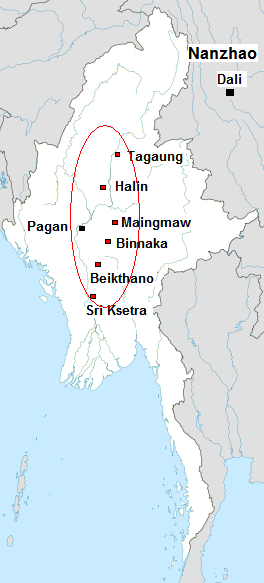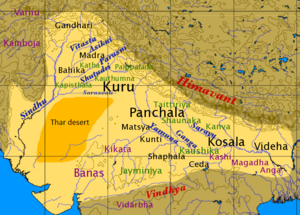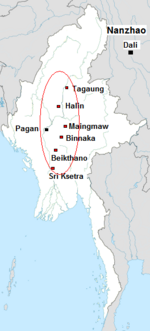Tagaung Kingdom facts for kids
Quick facts for kids
Kingdom of Tagaung
တကောင်း နေပြည်တော်
|
|||||||
|---|---|---|---|---|---|---|---|
| c. 1st century CE–c. 1050s | |||||||
 |
|||||||
| Capital | Tagaung | ||||||
| Common languages | Pyu, Burmese | ||||||
| Religion | Buddhism, animism, Hinduism | ||||||
| Government | Monarchy | ||||||
| Historical era | Classical Antiquity | ||||||
|
• Founding of Kingdom
|
c. 1st century CE | ||||||
|
• Fall of Kingdom
|
c. 1050s | ||||||
|
|||||||
The Tagaung Kingdom (Burmese: တကောင်း နေပြည်တော်) was an ancient city-state in what is now Myanmar. It existed around the first 1000 years of the Common Era. For a long time, Tagaung was thought to be a legendary place. But in 1832, a royal history book called Hmannan Yazawin said it was the first kingdom of Burmese monarchy.
This book claimed the kingdom started around 850 BCE. It said a prince named Abhiyaza from the same family as the Buddha founded it. Through him, later Burmese kings believed they were related to the Buddha. The book also mentioned another prince, Dazayaza, who started a second Tagaung dynasty around 600 BCE. Before this, the kings believed they came from a sun spirit and a dragon princess.
Scientists studying old sites have found proof that people lived in Tagaung during the Stone Age and Bronze Age. A city-state built by the Pyu started there in the early centuries CE. Old records often talk about different groups of people moving around and competing in the Tagaung area. The city-state became part of the powerful Pagan Empire in the mid-1050s.
Contents
Legends of Tagaung
A New Beginning
The story of Tagaung became very important to later kings. They wanted to show that their family line came from the Buddha himself. The Hmannan book says that Prince Abhiyaza (အဘိရာဇာ) and his followers left their home in India. They had lost a battle against a neighboring kingdom.
They traveled to what is now northern Myanmar. There, by the Irrawaddy river, they started a new kingdom called Tagaung. This was supposedly in 850 BCE.
The First Kings
The Hmannan book says Abhiyaza was the first king of Tagaung. He ruled for 25 years. He had two sons. The older son, Kanyaza Gyi, did not become king. His younger brother, Kanyaza Nge, took the throne.
Kanyaza Gyi went south and started his own kingdom in Arakan in 825 BCE. Kanyaza Nge became king, and after him, 31 more kings ruled Tagaung. Around 600 BCE, invaders from the northeast attacked the city. These invaders were called Taruk, which meant people from the northeast. The 33rd king, Binnaka Yaza, was killed.
The Second Dynasty
After Tagaung fell, the people split into three groups. One group moved south to a place called Thunapayanta. Pyus, Kanyans, and Thets already lived there. Another group went southeast and settled in an area that later became known as the 19 districts of Kyaukse.
A third group stayed in Tagaung. They were led by Naga Hsein, the queen of the killed king. She met Dazayaza, another prince from the Buddha's family. They married and built a new capital near Tagaung. After them, 16 more kings ruled. Around 483 BCE, invaders from the east attacked again. The 17th and last king of this line, Thado Maha Yaza, was defeated.
Tagaung's Lasting Story
Even after Tagaung fell, the royal family line was said to continue. In 503 BCE, the queen of Thado Maha Yaza had twin sons who were blind. The king wanted them killed, but the queen hid them. Later, the king found out they were alive and ordered them killed again.
The queen put her sons on a raft down the Irrawaddy river. On the river, they magically got their sight back. In 483 BCE, these brothers started a new kingdom much further south. It was called Sri Ksetra, near modern Pyay. Maha Thanbawa was the first king, followed by his brother, and then Maha Thanbawa's son, Duttabaung. Sri Ksetra lasted for almost 600 years.
Around 107 CE, Thamoddarit, a nephew of the last king of Sri Ksetra, founded the city of Pagan. The Buddha himself was said to have visited this spot. He supposedly said a great kingdom would rise there 651 years after his death. Later Burmese kingdoms, from Myinsaing to Konbaung, claimed they were related to the kings of Pagan. This made the Tagaung story important.
History and Evidence
Even though the story of Abhiyaza is a legend, old objects show that many places mentioned in the royal books have been lived in for at least 3,500 years. Tools from the Stone Age and Bronze Age have been found near Tagaung. This proves people lived there during the same time as the legendary Tagaung dynasties.
However, finding old tools is not the same as finding a city-state. Evidence shows that Tagaung became a city-state with triple walls only in the "early centuries CE." This was much later than the 850 BCE date in the legends. Tagaung has not been fully dug up by archaeologists, so more old evidence might still be found.
The old kingdoms of Tagaung, Sri Ksetra, and Pagan did exist. But they were often around at the same time, not one after the other as the legends say.
| Kingdom | Time per Hmannan (Legend) | Time per Archaeology (Fact) | What we know |
|---|---|---|---|
| Tagaung | 850 – 483 BCE | c. 1st/2nd century – 11th century CE | After 483 BCE, Tagaung is only briefly mentioned in records much later. |
| Sri Ksetra | 483 BCE – 94 CE | c. 5th/7th century – 11th century CE | Sri Ksetra later became the modern city of Pyay. |
| Pagan | 107 – 1298 CE | c. 849/876 – 1297 CE |
The old stories about Tagaung show what people believed at the time. The "Pyu realm" had many different groups of people. The records often mention groups moving and changing regions. Tagaung was a city-state until the early 11th century. It was then taken over by the Pagan Empire around the mid-1050s. King Anawrahta of Pagan made it one of his 43 forts in 1061.
Fact vs. Legend
The story of Abhiyaza first appeared in the Hmannan Yazawin in 1832. Older Burmese history books, written before the 18th century, did not mention Abhiyaza. Instead, they said the Burmese kings came from a hero named Pyusawhti, who was the son of a sun spirit and a dragon princess.
Historians believe the Abhiyaza stories started in the 1770s. Kings at that time wanted to promote a more traditional form of Buddhism. They wanted to show a direct link to the Buddha. In 1832, the Abhiyaza story officially replaced the older Pyusawhti legend. This new story claimed the kings were related to the Buddha's family.
Some Chinese history books also mention "Tagaung" (太公). But they describe it as a small town in northern Myanmar. Historians think the "Taruk" invaders mentioned in the Burmese chronicles were actually from the Nanzhao kingdom in 754 AD. The Hmannan Yazawin moved this event much earlier, to 6 BCE.
Because of these later added stories, European historians during the British rule in Burma doubted the old Burmese history books. They thought much of the early history was just copies of Indian legends. They also believed that no advanced civilization existed in Burma much before 500 CE.
See also
- Early Pagan Kingdom
- Sri Ksetra Kingdom



